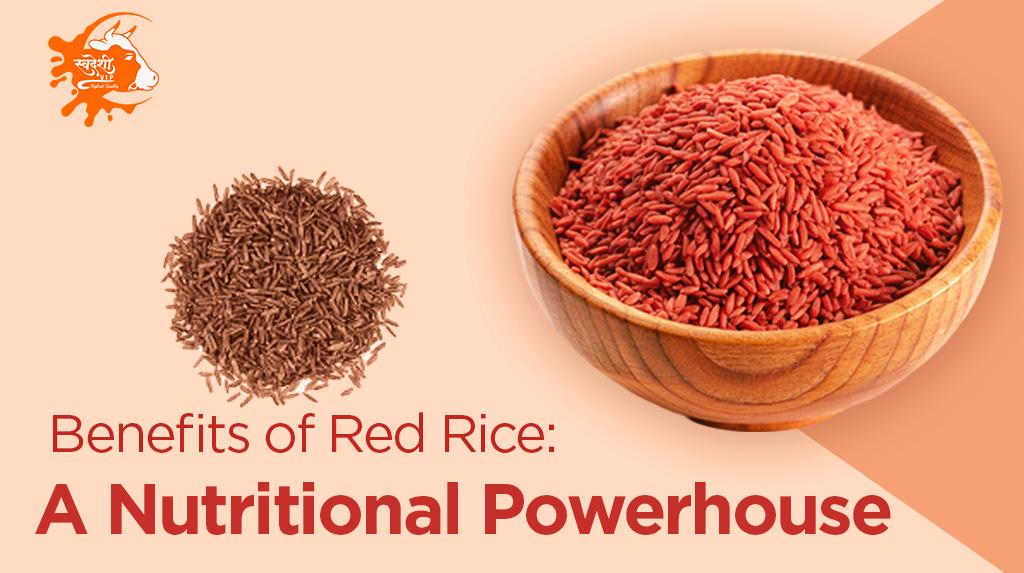
Carbs are known for global dominance, and rice is the supreme choice of grains; it is the king of any staple-fulfilling plate. If you are searching for a healthier alternative, leave behind white rice and pick our nutritional powerhouse; with exceptional health benefits, red rice also carries a delicious taste.
Today, red rice is standing and showcasing the array of vibrant well-being. With this blog, we focus on the importance of imbibing red rice into our regular diet and making it a valuable impact on the functioning of the body’s internal system.
Red cargo rice, or weedy rice, refers to the red rice grain. The name “red rice” comes from the grain’s rich outer coating and antioxidants, giving it a distinctive rusty brown colour. Making red rice a staple in your diet provides a flavorful and satisfying dish and offers a range of health benefits of red rice.
Red rice retains its nutritional content, unlike white rice, which loses its outer coating during processing. In India, it is known by several names, including Oryza long staminate, Matta rice, Palakkadan Matta rice, and Rakthashali.
It is primarily produced in India’s Tamil Nadu, Kerala, Madhya Pradesh, Orissa, and Karnataka. The Matta from Kerala, Matali and Jatu from Kullu, and Patni from Maharashtra are all popular types of weedy rice. Red rice is also highly prized in other countries, such as America, Korea, Sri Lanka, and China.
The rising popularity of red rice has been recognised for its mass health benefits, making it an essential choice for individuals.
Red rice provides a delightful experience for your taste buds and offers a healthy, long-lasting source of energy. The complex carbohydrate structure provides a steady release of energy, keeping the energy fuelled throughout the day.
Red rice is rich in fibre, which promotes healthy digestion, keeps happy guts alive, and puts stomach troubles aside for the day. It also relieves the dreaded bloating and discomfort and smooths the digestive system’s workings.
Red rice is a treasure trove packed with antioxidants and free radicals. These antioxidants are crucial in shielding the body’s cells from damage and decreasing the risk of chronic diseases. They act as 24/7 protection for the body.
Red rice has anthocyanins, which are responsible for improved heart health by declining inflammation and promoting better blood circulation. Say goodbye to heart problems.
Red rice makes a bold statement, making a bold move towards bad cholesterol. The soluble fibre present helps lower bad cholesterol, kicking out the effect of criminal cholesterol into the bay. Consuming red rice with A2 Gir cow milk will assist in resolving the problem of bad cholesterol.
Red rice is a nutritional powerhouse of minerals, vitamins, and antioxidants. These little red grains testify to their higher nutrient content.
Given below is the table that shows the brief outlook on nutrients present in red rice-
| Nutritional Components | Value per 100g |
| Energy | 356 kCal |
| Dietary Fiber | 11.10 grams |
| Iron | 1.11 mg |
| Protein | 8.89 grams |
| Fats | 3.33 grams |
| Sodium | 67 mg |
| Zinc | 30 mg |
| Potassium | 156 mg |
As people nowadays prioritise health and nutrition increasingly, red rice has become the star on everyone’s plate. People have become more concerned about their digestive health, skin conditions, and bone health. Its nutty flavour and vibrant uses make it a compulsory add-on to the daily intake of rice variety. It can be a culinary delight if used effectively, and the remarkable health benefits are just an eye-opener for the ones who want to change their lifestyle to the next level.
The benefits of Red rice are revolutionary facts that people are coming up with. Including red rice in your diet brings a host of nutritional benefits. Remember to make the change gradually for a smooth transition and well-being.
To order 100% organic and natural dairy products, visit swadeshivip
Red rice is a rich source of antioxidants, including anthocyanins, which may improve the health of our skin. It also improves blood circulation and may dilate the blood vessels to protect against asthma.
Red rice can be eaten daily and quickly included in the diet. It is an excellent option for people who look forward to weight loss.
Yes, red rice is perfect for the liver. It helps in treating high-fat diet-induced non-alcoholic fatty liver disease.
As per individuals, 60g of red rice should be consumed per individual.
Red rice has a GI score of less than 60 and offers only 23 grams of carbohydrates, making it a low-carb food suitable for diabetes.
No, red rice is not difficult to digest despite its high nutritional content. As such, it is a good option for digestion.
The research suggests that red rice has the highest level of antioxidants among the different types of rice, ten times more than brown rice.
Red rice is more expensive than white rice. One kg of red rice is currently Rs. 195 in the market.
Red rice is overloaded with fibre, vitamins, calcium, and iron content. B1 and B2 vitamins are found mainly in red rice.
Red rice has anti-ageing properties; the extract provides nourishment and hydration to the skin. It also helps improve the skin’s texture, leaving it smooth, supple, and radiant.
